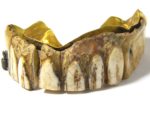 A set of early 19th century dentures made of gold and hippo ivory that was discovered by a metal detector hobbyist is going up for auction this month. The dentures were unearthed by bricklayer Peter Cross, an avid metal detectorist for the past 40 years, in Waterstock, Oxfordshire.
A set of early 19th century dentures made of gold and hippo ivory that was discovered by a metal detector hobbyist is going up for auction this month. The dentures were unearthed by bricklayer Peter Cross, an avid metal detectorist for the past 40 years, in Waterstock, Oxfordshire.
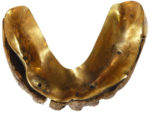 The ingenious false teeth were carved by hand from a single piece of ivory, the natural curvature of the tusk used to match the curvature of the jaw. Once carved, the ivory tooth arch was mounted to a gold base plate with pins. While parts of the gold plate have bent away from the ivory over the years, it would originally have been formed by hand on a swage block to fit a plaster model of the wearer’s jaw.
The ingenious false teeth were carved by hand from a single piece of ivory, the natural curvature of the tusk used to match the curvature of the jaw. Once carved, the ivory tooth arch was mounted to a gold base plate with pins. While parts of the gold plate have bent away from the ivory over the years, it would originally have been formed by hand on a swage block to fit a plaster model of the wearer’s jaw.
 The front six teeth are carved in naturalistic shape and size and the original enamel has been preserved keeping them white in color. The enamel was carved away from the “gum” area exposing an inner layer that is a brownish shade resembling real gums. The teeth in the back are
The front six teeth are carved in naturalistic shape and size and the original enamel has been preserved keeping them white in color. The enamel was carved away from the “gum” area exposing an inner layer that is a brownish shade resembling real gums. The teeth in the back are 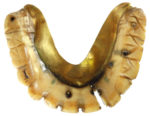 more crudely carved as they didn’t have to put on so much of a show. Still, the craftsman bothered to incise lines to suggest individual teeth and cross-hatching on top of the teeth creating a textured surface.
more crudely carved as they didn’t have to put on so much of a show. Still, the craftsman bothered to incise lines to suggest individual teeth and cross-hatching on top of the teeth creating a textured surface.
On the side is a surviving spring connected to a rivet. This is how the top and bottom parts of the dentures were connected to each other. Only the upper section has been found. Cross returned to the field several times in the hope of discovering the bottom half of the set, to no avail.
Mr Cross, who made the find in March this year, said: “I know this sounds crazy but when I first pulled them up out of the ground, I thought they were sheep’s teeth. When I began to clean off the mud and clay, I could see there was a gold plate – and that they were human false teeth.
“They would have belonged to a very wealthy person. They date back to between 1800 and 1850 and would have cost a fortune at the time. A dentist friend said the owner would have paid between £200 to £300 in the 1800s and that would have bought half the houses in Brill back then – a very affluent village.
“I’ve shown the teeth to many people and consulted the British Dental Association and the British Museum. Everyone’s amazed – and everyone wants to take a photo of them. They’re unique.
“I’m only aware of one other slightly similar set of false teeth and they belonged to American president George Washington and date back to the late 1700s. They’re on display in the States.”
There are quite a few gold and silver plates from historic dentures in the Portable Antiquities Scheme database, but only two of them still have teeth 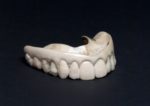 attached, and only a single tooth apiece. In both of those examples the teeth are porcelain. The Wellcome Collection has all kinds of historic dentures in its vaults and on display, including several carved entirely out of hippo ivory, plate and teeth together, and this striking example of an ivory upper with human front teeth.
attached, and only a single tooth apiece. In both of those examples the teeth are porcelain. The Wellcome Collection has all kinds of historic dentures in its vaults and on display, including several carved entirely out of hippo ivory, plate and teeth together, and this striking example of an ivory upper with human front teeth.
George Washington’s surviving set of false teeth is much more elaborate than the recently-discovered set. We know from his diaries and correspondence that despite his overall excellent health and attention to dental hygiene, Washington’s teeth and gums were a mess from when he 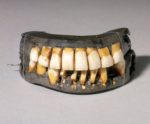 was a young man. By the time he was inaugurated the first President of the United States in 1789, he only had one of his original teeth left. He had many dentures over the years, none of them with the wood teeth of lore; some were carved out of animal ivory or actual animal teeth (horses, cows, donkeys), some used human teeth extracted Fantine-style from poor or enslaved people who were paid per tooth. The sole complete set of Washington’s dentures extant today is on display at Mount Vernon.
was a young man. By the time he was inaugurated the first President of the United States in 1789, he only had one of his original teeth left. He had many dentures over the years, none of them with the wood teeth of lore; some were carved out of animal ivory or actual animal teeth (horses, cows, donkeys), some used human teeth extracted Fantine-style from poor or enslaved people who were paid per tooth. The sole complete set of Washington’s dentures extant today is on display at Mount Vernon.
The antique chompers will go under the hammer at Hansons on November 25th. The presale estimate is £3,000 – £5,000 ($3,900 – $6,400). The sale price will be divided 50/25/25 between landowner, Mr. Cross and Diana Wild, his metal detecting buddy on the day of the find.